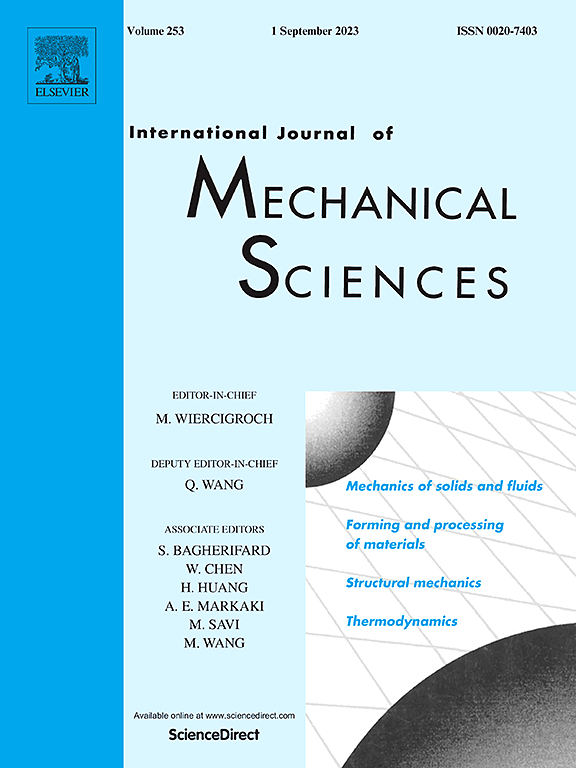扭曲双层石墨烯与钛纳米复合材料的力学行为
IF 7.1
1区 工程技术
Q1 ENGINEERING, MECHANICAL
International Journal of Mechanical Sciences
Pub Date : 2025-07-19
DOI:10.1016/j.ijmecsci.2025.110616
引用次数: 0
摘要
通过分子动力学(MD)模拟研究了扭曲双层石墨烯(TBLG)及其增强钛基纳米复合材料(TBLG- rt)的力学行为。首次系统地计算了TBLG的杨氏模量和剪切模量,在0°到30°的扭转角范围内,增量为1°。我们的研究结果表明,虽然杨氏模量表现出最小的角波动,但拉伸强度表现出各向异性:在曲折方向上降低,而在扶手椅方向上随着扭转角的增大而增加。此外,剪切模量在整个研究范围内的角依赖性可以忽略不计。一个重要的发现是,TBLG在大约29°~ 30°的临界扭转角下表现出横向各向同性材料特性。因此,在单轴拉伸和剪切模拟中,选择29.96°扭转配置的TBLG作为钛增强材料。采用扭转角分别为6.01°和12.90°的TBLG验证了TBLG- rt的角度无关性。MD模拟表明,与纯钛相比,即使最小的TBLG体积分数也能显著提高机械性能。然而,传统的微观力学模型(混合规则和Halpin-Tsai)和md衍生的结果在更高的强化分数之间出现了显著的差异。为了解决这种差异,我们提出了针对MD模拟数据校准的这些模型的修改版本,从而能够更准确地预测TBLG-RT复合材料的性能。此外,改进的微力学模型建立了一个跨长度尺度定制石墨烯增强复合材料的计算框架,将量子尺度的MD见解与宏观工程应用联系起来。本文章由计算机程序翻译,如有差异,请以英文原文为准。
Mechanical Behavior of Twisted Bilayer Graphene and Titanium Nanocomposites
This study investigates the mechanical behavior of twisted bilayer graphene (TBLG) and its reinforced titanium matrix nanocomposites (TBLG-RT) through molecular dynamics (MD) simulations. Young's modulus and shear modulus of TBLG are systematically calculated for the first time, across twist angles from 0° to 30° with 1° increments. Our results demonstrate that while Young's modulus exhibits minimal angular fluctuations, tensile strength displays anisotropic behavior: decreasing in the zigzag direction yet increasing in the armchair direction with larger twist angles. Furthermore, the shear moduli show negligible angular dependence across the studied range. A critical finding is that TBLG manifests transversely isotropic material properties at a critical twist angle of approximately 29°∼30°. Consequently, TBLG with a 29.96° twist configuration is selected for titanium reinforcement in uniaxial tensile and shear simulations. and the TBLG with twist angles of 6.01° and 12.90° are used to verify the angle independence of TBLG-RT. The MD simulations reveal that even minimal TBLG volume fractions induce substantial mechanical property enhancements compared to pure titanium. However, significant discrepancies emerge between conventional micromechanical models (Rule of Mixtures and Halpin-Tsai) and MD-derived results at higher reinforcement fractions. To address this divergence, we propose modified versions of these models calibrated against MD simulation data, enabling more accurate predictions of TBLG-RT composite performance. Furthermore, the modified micromechanical models establish a computational framework for tailoring graphene-reinforced composites across length scales, bridging quantum-scale MD insights with macroscopic engineering applications.
求助全文
通过发布文献求助,成功后即可免费获取论文全文。
去求助
来源期刊

International Journal of Mechanical Sciences
工程技术-工程:机械
CiteScore
12.80
自引率
17.80%
发文量
769
审稿时长
19 days
期刊介绍:
The International Journal of Mechanical Sciences (IJMS) serves as a global platform for the publication and dissemination of original research that contributes to a deeper scientific understanding of the fundamental disciplines within mechanical, civil, and material engineering.
The primary focus of IJMS is to showcase innovative and ground-breaking work that utilizes analytical and computational modeling techniques, such as Finite Element Method (FEM), Boundary Element Method (BEM), and mesh-free methods, among others. These modeling methods are applied to diverse fields including rigid-body mechanics (e.g., dynamics, vibration, stability), structural mechanics, metal forming, advanced materials (e.g., metals, composites, cellular, smart) behavior and applications, impact mechanics, strain localization, and other nonlinear effects (e.g., large deflections, plasticity, fracture).
Additionally, IJMS covers the realms of fluid mechanics (both external and internal flows), tribology, thermodynamics, and materials processing. These subjects collectively form the core of the journal's content.
In summary, IJMS provides a prestigious platform for researchers to present their original contributions, shedding light on analytical and computational modeling methods in various areas of mechanical engineering, as well as exploring the behavior and application of advanced materials, fluid mechanics, thermodynamics, and materials processing.
 求助内容:
求助内容: 应助结果提醒方式:
应助结果提醒方式:


